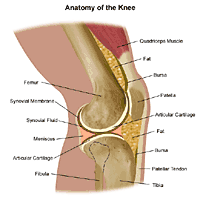Knee Replacement Surgery
Knee Replacement Surgery
When a knee is so severely damaged by disease or injury, an artificial knee replacement may be considered. During knee replacement surgery, joint surfaces are replaced by prostheses. The most common age for knee replacement is between 50 and 80 years old.
Who might be a candidate for knee replacement?
The most common condition that results in the need for knee replacement surgery is osteoarthritis. This is a degenerative joint disease that affects mostly middle-aged and older adults. Osteoarthritis is characterized by the breakdown of joint cartilage and bone in the knees. Other forms of arthritis, such as rheumatoid arthritis and arthritis that results from a knee injury can also lead to degeneration of the knee joint. In addition, fractures, torn cartilage, or torn ligaments also can lead to irreversible damage to the knee joint over the years.
The decision to replace the painful knee with an artificial one is a joint decision between you and your doctor. Other alternative treatments may first be used, including assistive walking devices, anti-inflammatory medicines, injections, and bracing.
What happens before the surgery?
In addition to a complete medical history, your doctor may do a complete physical exam, including X-rays, to ensure you are in good health before undergoing surgery. In addition, you may also meet with a physical therapist to discuss rehabilitation after the surgery and undergo blood tests (or other tests).
How is a knee replaced with an artificial knee?
Although each procedure varies, generally, surgery to replace a knee usually lasts about 2 hours. After the damaged bone and cartilage of the knee is removed, the orthopedic surgeon will place the new artificial knee in its place.
The most common type of knee prostheses used in replacement surgery is a cemented prosthesis. Uncemented prosthesis is not commonly used. Sometimes, a combination of the 2 types is used to replace a knee. A knee prosthesis is made up of metal with ceramic or plastic. A cemented prosthesis is attached to the bone with a type of epoxy. An uncemented prosthesis attaches to the bone with a fine mesh of holes on the surface. The bone grows into the mesh and attaches naturally to the prosthesis.
The prosthesis (artificial knee) is usually made up of these 3 components:
Tibial component (to replace the top of the tibia, or shin bone)
Femoral component (to replace the two femoral [thighbone] condyles and the patella groove)
Patellar component (to replace the bottom surface of the kneecap that rubs against the thighbone)
While undergoing surgery, you may be under general anesthesia or awake with spinal or epidural anesthesia.
After surgery
Knee replacement surgeries usually require an in-hospital stay of a few days. Even while in the hospital, you usually start physical therapy exercises to begin regaining range of motion in the knee. Physical therapy will continue at home. Pain medicine also will be given to keep you comfortable.
The incision will have stitches or staples that will be removed after a few weeks.
Updated:
May 25, 2018
Sources:
Total Knee Arthroplasty, Up To Date
Reviewed By:
Freeborn, Donna, PhD, CNM, FNP,Joseph, Thomas, N., MD
